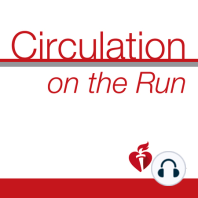18 min listen
Circulation March 5, 2019 Issue
ratings:
Length:
22 minutes
Released:
Mar 4, 2019
Format:
Podcast episode
Description
Dr Carolyn Lam: Welcome to Circulation on the Run, your weekly podcast summary and backstage pass to the journal and its editors. I'm doctor Carolyn Lam, associate editor from the National Heart Center, and Duke National University of Singapore. Dr Greg Hundley: And I'm Greg Hundley, associate editor from the Pauley Heart Center at VCU Health in Richmond, Virginia. Dr Carolyn Lam: Have you heard of long non-coding RNAs? Well, they are definitely the hot topic and our feature paper today discusses the first demonstration of the importance of a linked RNA in atherosclerotic lesions not just in mice but also in humans. You have to listen on, it's coming up right after our copy chat. Greg, what are your picks upon the journal this week? Dr Greg Hundley: The first paper I wanted to discuss comes from France, and it's basically looking at ambulance density and outcomes after out of hospital cardiac arrest from Florence Dumas from Hôpital Cochin in Paris, France. This manuscript addresses the geographic disparities and survivorship of out of hospital cardiac arrest and the relevance of the patients characteristics versus whether ambulances are equipped with those trained in basic or advanced cardiac life support. So, what they did they had nineteen neighborhoods in Paris, and the number of BLS trained versus ALS ambulances was collected, and the authors assessed that respective associations of socio-economic characteristics of the patient population and the ambulance resources of these neighborhoods and compared those with successful return of spontaneous circulation or risk as the primary end point and then survival of out of hospital discharge as the second end-point. So, they had 80754 non-traumatic out of hospital cardiac arrests across the Paris area. 42% at ROSK 9% head survival at discharge, and after accounting for the patient's socio-economic status, greater than one and a half advanced cardiac life support ambulances per neighborhood and greater than 4 basic cardiac support basic life support units per neighborhood were associated with ROSK, but only the 1.5 ALS units per neighborhood were associated with survival. Dr Carolyn Lam: Oh, interesting Greg. So does this we need more advanced life support units? Dr Greg Hundley: So, Paul Dorian from St. Micheal's Hospital in Toronto, Canada wrote an excellent editorial, and one point he made related to these ALS units is that it was really a very small 1.3 adjusted odd ratio for survival to hospital discharge, and it's important to note that although the increase in survival was associated with more ALS units, there were many other variables that were likely important and not recorded in this study. For example, including the time to collapse, to calling for EMS, the time from the call to the deployment of that ALS unit to the scene, the time from collapse to the defibrillation, the total "no flow time" sort of in quotation, which is the total duration of collapse until CPR is started and so I think one of the points in this observational study is there could've been many differences that would've associated with the findings, interesting findings how about one of the papers that you liked? Dr Carolyn Lam: So, the paper that I selected here is a first time that a targeted anti-inflammatory therapy has been shown to reduce hospitalization for heart failure and at-risk patients. So, you know that some clinical inflammation associates with an increased risk of heart failure and associates with the worst prognosis in patients with heart failure, and yet, so far, treatments specifically directed at reducing inflammation in patients with heart failure have not been shown to improve clinical outcomes. That's why today's paper is so special and it's from Dr Everett and colleagues from Brigham and
Released:
Mar 4, 2019
Format:
Podcast episode
Titles in the series (100)
Circulation January 23, 2018 Issue by Circulation on the Run
